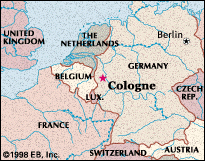CologneGerman Köln,
Cologne is situated on a fertile lowland plain, about 21 miles (34 km) northwest of Bonn, and has a temperate but humid climate. The city's layout follows the semicircular pattern it assumed in 1180 when the city wall was built; the flat side of the semicircle is bounded by the Rhine. Administrative annexations of surrounding communities in 1975 significantly enlarged the city's area and population; heavily industrialized and rural residential districts surround the modern city on both banks of the river. Banking and trade have been prominent in the economy of Cologne since the Middle Ages. Wine and textile production are other well-established activities. Insurance has become of great importance, as have engineering, metalworking, and petrochemical, pharmaceutical, and lignite-extraction industries. Other manufactures include engines, chocolate, and eau de cologne. The perimeter of Cologne's inner semicircle is defined by ring roads, called the Ringstrassen, which in the 19th century replaced the medieval fortifications. Greenbelts stretch alongside the Ringstrassen. The main shopping and business streets, such as the north-south Hohe Strasse and the west-east Schildergasse, as well as the city's historic buildings, lie within the Ringstrassen. Despite the destruction of about 90 percent of the central city during World War II, Cologne's appearance still reflects its history; religious and secular buildings and monuments of all periods remained standing or have been rebuilt. The most impressive architectural feature of the city is the Cologne Cathedral, which was built between the 13th and the 19th century. It is the largest Gothic church in northern Europe and houses a collection of relics and art treasures that span a millennium. Numerous Romanesque churches date from the 11th to the 13th century. Secular medieval buildings such as the Overstolzenhaus, the Gothic Town Hall, and the Gürzenich, or Festhaus (banquet hall), suffered damage in World War II but have undergone extensive reconstruction. Institutions of higher learning in the city include the University of Cologne (founded in 1388, dissolved during the French Revolutionary occupation of the city, and refounded in 1919) and professional, trade, and art schools. Among the city's cultural institutions are the Wallraf-Richartz Museum (with a fine collection of Old Masters), the Ludwig Museum (with an excellent wide-ranging collection of modern art), and several other museums. City mass transit consists of bus, streetcar, and subway service. Because of its favourable location, Cologne has become a major rail junction and an important inland port. Autobahns connect the city with other major German urban centres. The Cologne/Bonn Airport has a helicopter landing ground. Area city, 156 square miles (405 square km). Pop. (1992 est.) 956,690. Copyright © 1994-2002 Encyclopædia Britannica, Inc.
Sources
Web |
 |
 |
Gregory Brown
513 Agnes Arnold Hall
Department of Philosophy
University of Houston
Houston, TX 77204-3004
513 Agnes Arnold Hall
Department of Philosophy
University of Houston
Houston, TX 77204-3004




 largest city of
largest city of